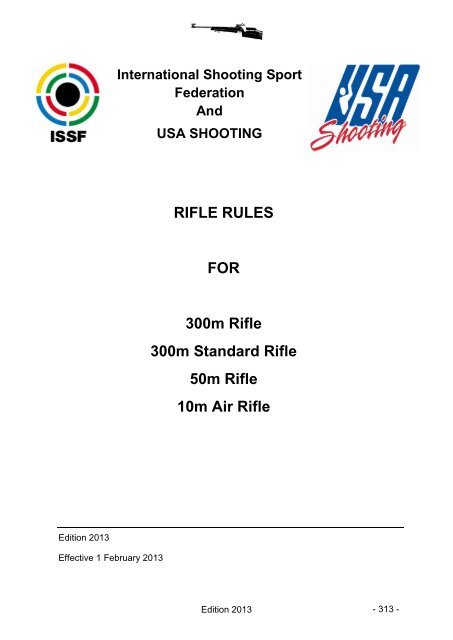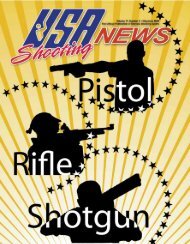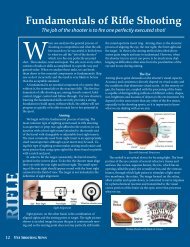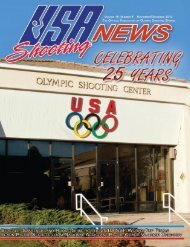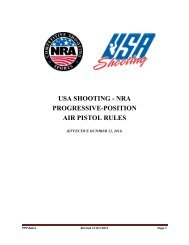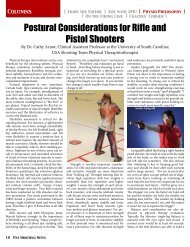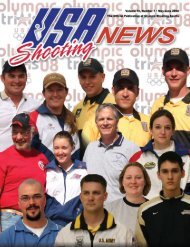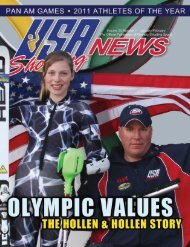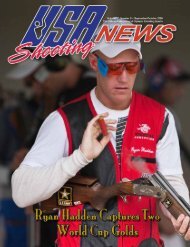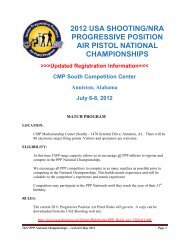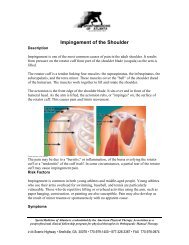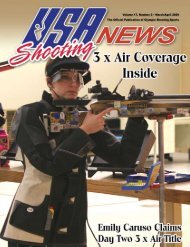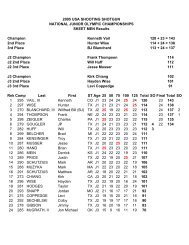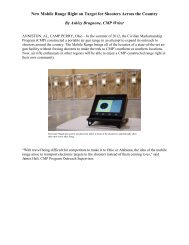You also want an ePaper? Increase the reach of your titles
YUMPU automatically turns print PDFs into web optimized ePapers that Google loves.
7.4.2.4 The pistol grip must not extend more than 60mm from a verticalplane that is perpendicular to the centerline of the barrel.7.4.2.5 Material that gives increased grip may not be added to the forend,pistol grip or lower part of the stock.7.4.2.6 WeightsBarrel weights within a radius of 30 mm from the center ofthe barrel are permitted. Barrel weights may be moved alongthe barrel; andAny other weights must be within the dimensions of thestock.7.4.3 Standards for 300m Standard <strong>Rifle</strong> OnlyAll 300m Standard <strong>Rifle</strong>s must conform to the specificationsshown in the <strong>Rifle</strong> Measurements Table and with the followingrestrictions:The minimum trigger pull is 1500 grams. The trigger pullmust be measured with the barrel in a vertical position.Trigger weight control checks must be conductedimmediately after the last series. A maximum of three (3)attempts to lift the weight are allowed. Any athlete whose riflefails the test must be disqualified;The rifle must not be removed from the firing line during thecourse of fire except with the permission of range officials;The same rifle must be used in all positions without change.The adjustment of the butt plate and hand stop or thechanging of front sight inserts or the adjustment of the rearsight or its eyepiece are permitted. The removal of the cheekpiece during competition is permitted for barrel cleaning andbolt removal under supervision of the Jury; but its positionmust not be changed when it is replaced; andThe overall length of the barrel including any extension tube,measured from the breech face to the apparent muzzle, mustnot exceed 762 mm.7.4.4 Standards for 10m Air <strong>Rifle</strong> OnlyAny type of compressed air or gas rifle that conforms to thespecifications in the RIFLE MEASUREMENTS TABLE and thefollowing additional restrictions:The total length of the air rifle system measured from theback end of the mechanism to the apparent muzzle must notexceed 850 mm; andThe front sight may not extend beyond the apparent muzzle.- 318 -For Use in <strong>USA</strong> <strong>Shooting</strong> SanctionedCompetitions
- 319 -7.4.4.1 <strong>Rifle</strong> Measurements Table (Please note J2 on the drawing below.)Edition 2013 Edition (First 2013 Print, 11/2012)Copyright: ISSF- 319 -
Measurements for Dimensions C, D, E, F, and J, are from the Center line of the Barrel300mKeyRIFLE FEATUREStandard<strong>Rifle</strong>Air <strong>Rifle</strong>A Length of front sight tunnel 50 mm 50 mmB Diameter of front sight tunnel 25 mm 25 mmCDistance from center of the front sight ring ortop of post to center of bore either directlyabove or offset (except for those athletes firingfrom the right shoulder but using their left eye).60 mm 60 mmD Depth of fore-end 90 mm 90 mmE Lowest point of pistol grip 160 mm 160 mmFLowest point of stock or toe of butt plate withthe butt plate in its maximum downwardposition220 mm 220 mmG Depth of curve of butt plate 20 mm 20 mmH Heel to toe length of butt plate 153 mm 153 mmI Maximum thickness (breadth) of fore-end 60 mm 60 mmJ1J2KLMaximum distance of cheek piece from avertical plane perpendicular to the center line ofthe barrelMaximum distance of any part of the pistol gripfrom a vertical plane perpendicular to the centerline of barrelOffset of butt plate parallel to the center line ofthe normal end of the butt left or right.Trigger weight - No Set Trigger40 mm 40 mm60 mm 60 mm15 mm 15 mm1500 gramsminimumFreeM Weight with sights (and hand stop 300m) 5.5 kg 5.5 kgNOThe front sight must not extend beyond theapparent muzzle of the rifle of both, 300mStandard or Air <strong>Rifle</strong>Standard <strong>Rifle</strong>: The overall length of the barrelincluding extension (from the muzzle to thebreech face)Must notextendMust notextend762 mm ---O1 Air <strong>Rifle</strong>: Total length of the Air <strong>Rifle</strong> system --- 850 mm- 320 - Edition 2013 (First Print, 11/2012)Copyright: ISSF
7.4.5 Standards for 50m <strong>Rifle</strong>sAll rifles chambered for rimfire 5.6 mm (.22” cal.) Long <strong>Rifle</strong>cartridges are permitted:The weight of the rifle may not exceed 8.0 kg for men with allaccessories used including palm rest or hand stop;The weight of the rifle may not exceed 6.5 kg for women,with all accessories used including the palm rest or handstop;Weights on or in the lower part of the stock or butt-stock,may not extend horizontally further from the centerline of thebarrel than the distance of the maximum extension of thecheek-piece from the centerline of the barrel. Weightscannot extend further to the rear than a line perpendicular tothe deepest point in the butt-plate; andWeights on the rifle fore-end may extend no lower than 90mm below the centerline of the barrel and not further forwardthan 700 mm from the back (rear) end of the system.Edition 2013- 321 -
7.4.5.1 Butt Plate and HookA butt hook that complies with the following restrictions may beused;The butt hook projecting rearward from the bottom of the buttplate must not extend more than 153 mm (A) past the rear ofa line that is perpendicular to a line drawn through the axis ofthe bore of the rifle, and that is tangent to the deepest part ofthe butt plate depression that normally rests against theshoulder;The butt hook projecting from the bottom of the butt platemust have a total outside length around any curve or bend ofnot more than 178 mm (B);The top projection of the butt plate must not extend morethan 25 mm to the rear of this perpendicular line; andAny devices or weights projecting forward from the lowerportion of the butt plate are prohibited.7.4.5.2 Palm RestsA palm rest is any attachment or extension below the fore-end thataids the support of the rifle by the forward hand in the standingposition. Such extensions must not extend more than 200 mmbelow the center line of the barrel.7.4.5.3 Standards for 300m <strong>Rifle</strong>sStandards for 300m <strong>Rifle</strong>s are the same as for the 50m <strong>Rifle</strong> (menand women). See 7.4.5 and the RIFLE SPECIFICATION TABLE.- 322 - Edition 2013 (First Print, 11/2012)Copyright: ISSF
7.4.6 Ammunition<strong>Rifle</strong> Caliber Other specifications50m5.6 mm Rimfire Long <strong>Rifle</strong>. Only bullets made of(.22“) lead or similar soft material are permitted.10m4.5 mm Projectiles of any shape made of lead or(.177") other soft material are permitted.Ammunition of any description that may be300mMaximum fired without any danger to athletes or8 mm range personnel. Tracer, armor piercing,and incendiary ammunition is prohibited.7.5 CLOTHING REGULATIONSSee the General Technical <strong>Rules</strong> for general standards regardingclothing and the testing of clothing (Rule 6.7).7.5.1 General Standards for <strong>Rifle</strong> Clothing7.5.1.2 All rifle competition clothing may be inspected on a one-time onlybasis at an ISSF Championship. Equipment Control certificationmust be retained with inspected equipment. Any inspectedequipment or apparel that is changed must be re-inspected.7.5.1.3 All shooting jackets, shooting trousers and shooting gloves mustbe made of flexible material that does not materially change itsphysical characteristics, that is, become stiffer, thicker or harder,under commonly accepted shooting conditions. All lining, paddingand reinforcements must meet the same specifications. Any liningor padding must not be quilted, cross-stitched, glued or otherwiseaffixed to the outer clothing layer other than at normal tailoringpoints. All lining or padding must be measured as a part of theclothing.7.5.1.4 Only one (1) shooting jacket, only one (1) pair of shooting trousersand only one (1) pair of shooting shoes may be approved byEquipment Control for each athlete for all <strong>Rifle</strong> events in any ISSFChampionship. If an athlete has more than one (1) item of rifleclothing (jacket, trousers and shooting shoes) which has beenpassed by Equipment Control then he must declare which item willbe used for this Championship. This does not prevent the athletefrom using ordinary athletic type training trousers or normalathletic type training shoes in any event or position. The jacketmust be capable of being used in all three (3) positions (prone,standing and kneeling) and must meet all other specifications inorder to be approved for the competition. Any item of clothingwhich fails to pass at Equipment Control may be retested afteralterations are made.7.5.1.5 Before and during tests the clothing must not be temporarilymanipulated by heat or other means. Permanent alterations maybe made to clothing. Clothing items may be removed fromEquipment Control for this purpose and resubmitted. If a clothingitem is resubmitted for a second or subsequent test during thesame Championship, a reinspection fee of EUR 20.00 will apply.Edition 2013- 323 -
<strong>USA</strong>S 7.5.1.5Does not apply in <strong>USA</strong> <strong>Shooting</strong> Sanctioned Competitions7.5.1.6 Manipulation of the material after examination (sprays, etc.) will bepenalized according to the rules.7.5.1.7 If shorts are worn during competitions, the bottom of the leg mustbe no less than 15 cm above the center of the kneecap.7.5.2 Clothing Measurement Standards7.5.2.1 Thickness Standards<strong>Rifle</strong> competition clothing must comply with these thicknessmeasurement standards:MeasurementUnderwearThickness Jackets Trousers Shoes GlovesLocationNormal Single 2.5 mm 2.5 mm 4.0 mm — 2.5 mmNormal Double 5.0 mm 5.0 mm — — 5.0 mmNormal Total — — — 12.0 mm —Reinforcements Single 10.0 mm 10.0 mm — — —Reinforcements Double 20.0 mm 20.0 mm — — —No measurement greater than the thickness measurementstandards in the chart may be approved (zero tolerance).7.5.2.2 Stiffness Measurement Standards<strong>Rifle</strong> competition clothing must comply with these stiffnessmeasurement standards:If the measuring cylinder is depressed at least 3.0 mm, thematerial is acceptable;If a measurement below 3.0 mm is displayed, the material istoo stiff. No measurement below the minimum measurementof 3.0 mm may be approved; andEvery part of the jacket or trousers must be capable of beingmeasured with the 60 mm measuring cylinder. If a part is toosmall for normal testing (no flat area 60 mm or larger),measuring must be done over the seams.7.5.2.3 Shoe Sole Flexibility StandardThe soles of athletes’ shoes must bend at least 22.5 degreeswhen a force of 15 Newton-Meters is applied to the heel areawhile the boot or shoe is clamped in the testing device.(<strong>USA</strong>S Clarification: <strong>Shooting</strong> shoe flexibility will not be adopted. Athletes making any<strong>USA</strong>S teams will be expected to comply with this rule before any travel with theteam.)7.5.3 <strong>Shooting</strong> ShoesNormal street type or light athletic shoes are permitted in allpositions. Special shooting shoes not exceeding the followingspecifications may be worn only in 10m and 50m 3 Positions- 324 - Edition 2013 (First Print, 11/2012)Copyright: ISSF
events. Special shooting shoes must not be worn in <strong>Rifle</strong> Proneevents:7.5.3.1 The material of the upper part (above the line of the sole) must beof soft, flexible, pliable material, not thicker than 4 mm, includingall linings, when measured on any flat surfaces such as point D inthe drawing of the shoe.7.5.3.2 The shoe sole must be constructed of the same material that isflexible in the entire forward part of the foot. Athletes may useremoveable inner soles or inserts in their shoes, but any insertsmust also be flexible in the forward part of the foot.7.5.3.3 To demonstrate that soles are flexible, athletes must walk normally(heel-toe) at all times while on the FOP. A warning will be givenfor the first offense, a two-point penalty and disqualification will begiven for subsequent violations.7.5.3.4 The height of the shoe from the floor to the highest point(Dimension C, <strong>Shooting</strong> Shoe Table) mut not exceed two thirds(2/3) of the length.7.5.3.5 If an athlete wears shoes, they must be a matched pair externally.Shoe Measurements Athletes shoes must not exceed themaximum dimensions shown in the drawing and chart:(<strong>USA</strong>S Clarification: <strong>Shooting</strong> shoe measurements will not be adopted. Athletesmaking any <strong>USA</strong>S teams in will be expected to comply with this rule before any travelwith the team.)A. Maximum thickness of sole at the toe: 10 mm.B. Overall length of shoe: According to size of wearer's foot.Maximum height of shoe: Not to exceed two-thirds (2/3)C.length of B.D. Upper part of shoe material maximum thickness 4 mm.The shoe sole must follow the external curvature of the shoe andmay not extend more than 5.0 mm beyond the externaldimensions of the shoe at any point. Toes or heels may not becut square or flat.Edition 2013- 325 -
7.5.4 <strong>Shooting</strong> Jacket7.5.4.1 The body and sleeves of the jacket, including the lining, must notexceed 2.5 mm in single thickness and 5.0 mm in doublethickness at any point where flat surfaces may be measured. Thejacket must not be longer than the bottom of the balled fist (seeJacket Table).7.5.4.2 Closure of the jacket must be only by non-adjustable means e.g.buttons or zippers. The jacket must not overlap more than 100 mmat the closure (see Jacket Table). The jacket must hang loosely onthe wearer. To determine this, the jacket must be capable of beingoverlapped beyond the normal closure by at least 70 mm,measured from the center of the button to the outside edge of thebutton hole. The measurement will be taken with the arms at thesides. A measurement must be made with an overlap gauge with atension of 6.0 kg to 8.0 kg. The area surrounding the button hole islimited to a maximum of 12 mm, and this area may exceed thepermitted 2.5 mm thickness.7.5.4.3 All straps, laces, bindings, seams, stitching or devices which maybe construed as artificial support are prohibited. However it ispermitted to have one (1) zipper or not more than two (2) straps totake up loose material in the area of the shoulder pad (see JacketTable). No other zipper or other closing or tightening device ispermitted other than those specified in these <strong>Rules</strong> and Diagrams.7.5.4.4 The construction of the back panel may include more than one (1)piece of material provided this construction does not stiffen orreduce the flexibility of the jacket. All parts of the back panel mustcomply with the thickness maximum of 2.5 mm and the stiffnessminimum of 3.0 mm.7.5.4.5 The construction of the side panel may not place any horizontalseam or seams under the elbow of the support arm in the standingposition.(<strong>USA</strong>S Clarification: <strong>USA</strong> <strong>Shooting</strong> will not adopt this rule. Any athlete making any<strong>USA</strong>S Team will be required to comply before any team travel.)7.5.4.6 The athlete must be capable of fully extending both arms(straighten sleeves) while wearing the buttoned jacket. In theprone and kneeling positions, the sleeve of the shooting jacketmust not extend beyond the wrist of the arm on which the sling isattached. The sleeve must not be placed between the hand orglove and the fore-end of the stock when the athlete is in theshooting position.7.5.4.7 No Velcro, sticky substance, liquid, or spray may be applied to theoutside or inside of the jacket, pads or shoes and/or floor orequipment. Roughening the material of the jacket is permitted.Violations will be penalized according to the <strong>Rules</strong>.7.5.4.8 <strong>Shooting</strong> jackets may have reinforcement patches added only totheir outside surfaces subject to the following limitations:- 326 - Edition 2013 (First Print, 11/2012)Copyright: ISSF
Maximum thickness, including jacket material and all linings:10 mm single thickness or 20 mm when measured as adouble thickness;Reinforcement may be added on both elbows but must notextend to more than half (1/2) of the circumference of thesleeve. On the arm which holds the sling, the reinforcementmay extend from the upper arm to a point 100 mm from theend of the sleeve. The reinforcement on the opposite armmay have a maximum length of 300 mm;Only one (1) hook, loop, button or similar device may befastened to the outside of the sleeve or shoulder seam on thesling arm to prevent the sling from sliding;Reinforcement on the shoulder where the butt plate restsmust not be longer than 300 mm in the longest dimension(see Jacket Table);All inside pockets are prohibited; andOne (1) external pocket is permitted, located on the rightfront side (left front side for left hand athletes) of the jacket.The maximum size of the pocket is 250 mm high from thelower edge of the jacket and 200 mm wide.Edition 2013- 327 -
<strong>Shooting</strong> Jacket Measurements <strong>Shooting</strong> jackets must mustcomply with the specifications shown in the drawing:<strong>Shooting</strong> Trousers7.5.5 The trousers, including the lining, must not exceed 2.5 mm insingle thickness and 5 mm in double thickness at any point whereflat surfaces may be measured. The top of the trousers must not fitor be worn higher on the body than 50 mm above the crest of thehipbone. All pockets are prohibited. All drawstrings, zippers orfasteners to tighten the trousers around the legs or hips areprohibited. To support the trousers only a normal waist belt notmore than 40 mm wide and 3 mm thick or braces (suspenders)may be worn. If a belt is worn in the standing position, the buckleor fastening must not be used to support the left arm or elbow. Thebelt must not be doubled, tripled etc. under the left arm or elbow. Ifthe trousers have a waistband, it may not be more than 70 mmwide. If the thickness of the waistband exceeds 2.5 mm, a waistbelt is not permitted. If a waist belt is not worn, the absolutemaximum thickness of the waistband is 3.5 mm. There can be amaximum of seven (7) belt loops, not more than 20mm in width,with at least 80mm between belt loops. The trousers may be- 328 - Edition 2013 (First Print, 11/2012)Copyright: ISSF
(<strong>USA</strong> <strong>Shooting</strong> Clarification:removed to meet the new ruleclosed by one (1) hook and up to five (5) eyes, or up to five (5)adjustable snap fasteners, or similar closure or Velcro that mustnot be multilayered. Only one (1) type of closure is permitted. AVelcro closure combined with any other closure is prohibited. Thetrousers must be loose around the legs. If special shootingtrousers are not worn, ordinary trousers may be worn providingthey do not give artificial support to any part of the body.The seat pad on current trousers may simply be7.5.5.2 Zippers, buttons, Velcro or similar non-adjustable fasteners orclosures, may be used in the trousers only in the following places:One type of fastener or closure in the front to open and closethe trouser fly. The fly must not be lower than the level of thecrotch;Any holes that cannot be closed are permitted; andOnly one (1) other fastener is permitted in each trouser leg.The opening (fastener) must not start closer than 70 mmfrom the top edge of the trousers. It may, however, extend tothe bottom of the trouser leg (see Jacket and TrousersTable). One (1) fastener is permitted either in the front of theupper leg or the back of the leg, but not in both places in one(1) leg.7.5.5.3 Reinforcements may be added to both knees of the trousers. Kneereinforcements may have a maximum length of 300 mm and mustnot be wider than half the circumference of the trousers leg. Thethickness of reinforcement including the trousers material and anylinings must not exceed 10 mm in single thickness (20 mm doublethickness).7.5.5.4 <strong>Shooting</strong> trousers must not be worn in the <strong>Rifle</strong> Prone events, butthey may be worn in the prone stages of <strong>Rifle</strong> 3 Positions events.7.5.5.5 <strong>Shooting</strong> Trousers Measurements<strong>Shooting</strong> Trousers must comply with the specifications shown inthe drawing:Edition 2013- 329 -
7.5.6 <strong>Shooting</strong> Gloves7.5.6.1 The total thickness must not exceed 12 mm when measuring frontand back materials together at any point other than on seams andjoints.7.5.6.2 The glove must not extend more than 50 mm beyond the wristmeasured from the center of the wrist knuckle (see drawing). Anystrap or other closure device at the wrist is prohibited. However, aportion of the wrist may be elasticated to enable the glove to beput on, but it must leave the glove loose around the wrist.Wristknuckle7.5.7 Underclothing7.5.7.1 Clothing worn under the shooting jacket must not be thicker than2.5 mm single thickness or 5 mm double thickness. The sameapplies to all clothing worn under the trousers.7.5.7.2 Only normal personal undergarments and/or training clothing thatdoes not immobilize or unduly reduce the movement of theathlete’s legs, body or arms may be worn under the shootingjacket and/or trousers. Any other undergarments are prohibited.7.5.8 Equipment and Accessories7.5.8.1 Spotting Telescopes50 mm- 330 - Edition 2013 (First Print, 11/2012)Copyright: ISSF
<strong>USA</strong>S 7.5.7.1A7.5.8.2 Slings7.5.8.3 <strong>Rifle</strong> RestsThe use of telescopes not attached to the rifle to locate shots andjudge wind is permitted for 50m and 300m events only.The use of telescopes not attached to the rifle to locate shots andto judge the wind is permitted 50m & 300m events only. The useof spotting telescopes is permitted at <strong>USA</strong>S sanctioned events.Maximum sling width is 40 mm. The sling must be worn only onthe upper part of the left arm and from there be connected to theforend of the rifle stock. Slings may be attached to the forend ofthe rifle at a single point only. The sling must pass along one sideof the hand or wrist only. No part of the rifle may touch the sling orany of its attachments except at the sling swivel and hand stop.The use of a rifle rest for resting the rifle between shots ispermitted providing that no part of the stand is higher than theathlete’s shoulders when in the standing position. A stand forresting the rifle must not be placed in front of the shooting table orbench in the standing position. A kneeling roll may be used as arifle rest. Care must be exercised that while resting the rifle, it doesnot intrude on the athlete one either side. For safety while the rifleis on the rifle rest, it must be held by the athlete.7.5.8.4 <strong>Shooting</strong> Box or Bag7.5.8.5 Kneeling RollThe shooting box or bag must not be placed forward of theathlete's forward shoulder on the firing line, except that in thestanding position a shooting box or bag, table, or stand may beused as a rifle rest between shots. The shooting box or bag, tableor stand must not be of such size or construction as to interferewith athletes on adjacent points or to constitute a wind break.Only one (1) cylindrically shaped roll is allowed for shooting in thekneeling position. The dimensions are a maximum of 25 cm longand 18 cm in diameter. It must be made of soft and flexiblematerial. Binding or other devices to shape the roll are notpermitted.7.5.8.6 Kneeling Heel Pad A separate piece of flexible, compressiblematerial with maximum dimensions of 20 cm x 20 cm may beplaced on the heel in the kneeling position. The kneeling heel padmay be no thicker than 10mm when compressed with themeasuring device used to measure rifle clothing thickness.(<strong>USA</strong>S Clarification: <strong>USA</strong>S is adopting the no seat pad rule for shooting pants. It issuggested to use the removed seat pad as the heel pad. The heel pad will bemeasured and tested in equipment control.)7.5.8.7 Visor or CapA cap or visor may be worn, but it must not touch or rest on therear sight while the athlete is shooting. The cap or visor mayEdition 2013- 331 -
extend forward of the athlete’s forehead no more than 80 mm andmay not be worn in a way that makes it a side blinder.7.6 SHOOTING EVENT PROCEDURES AND COMPETITIONRULES7.6.1 <strong>Shooting</strong> Positions7.6.1.1 Prone7.6.1.2 StandingThe athlete may lie on the bare surface of the firing point oron the shooting mat;He may also use the mat by resting his elbows on it.The body must be extended on the firing point with the headtoward the target;The rifle may be supported by both hands and one shoulderonly;The cheek may be placed against the rifle stock.The rifle may be supported by the sling, but the forendbehind the left hand must not touch the shooting jacket;No part of the rifle may touch the sling or its attachments;The rifle must not touch, or rest against, any other point orobject;Both forearms and sleeves of the shooting jacket forward ofthe elbow must be visibly raised from the surface of the firingpoint;The athlete's sling (left) forearm must form an angle not lessthan 30 degrees from the horizontal, measured from the axisof the forearm;The right hand and/or arm may not touch the left arm,shooting jacket or sling; and<strong>Shooting</strong> trousers must not be worn in the <strong>Rifle</strong> Proneevents.The athlete must stand free, without any artificial or othersupport, with both feet on the firing point surface or on theshooting mat;The rifle may be held with both hands and the shoulder orthe upper arm near the shoulder and the part of the chestimmediately adjacent to the right shoulder;The cheek may be placed against the rifle stock;The rifle must not touch the jacket or chest beyond the areaof the right shoulder;(<strong>USA</strong>S Clarification: No part of the rifle or the supporting hand may touch the nonsupportingside of the jacket or chest area beyond the center line of the chest.)- 332 - Edition 2013 (First Print, 11/2012)Copyright: ISSF
7.6.1.3 KneelingThe left upper arm and elbow may be supported on the chestor on the hip. If a belt is worn the buckle or fastening mustnot be used to support the left arm or elbow;The rifle must not touch or rest against any other point orobject;A palm rest may be used but not in 300m Standard <strong>Rifle</strong> or10m Air <strong>Rifle</strong> events;A hand stop/sling swivel is not allowed in this position for300m Standard <strong>Rifle</strong> and 10m Air <strong>Rifle</strong>;In this position, the use of the sling is prohibited; andThe right hand may not touch the left hand, left arm or the leftsleeve of the shooting jacket.The athlete may touch the firing point surface with the toe ofthe right foot, the right knee and the left foot;The rifle may be held with both hands and the right shoulder;The cheek may be placed against the rifle stock;The left elbow must be supported on the left knee;The point of the elbow must not be more than 100 mm overor 150 mm behind the point of the knee;The rifle may be supported by the sling but the forend behindthe left hand must not touch the shooting jacket;No part of the rifle may touch the sling or its attachments;The rifle must not touch or rest against any other point orobject;If the kneeling roll is placed under the right foot or ankle, thefoot must not be turned at an angle of more than 45 degrees;If the kneeling roll is not used, the foot may be placed at anyangle. This may include placing the side of the foot and thelower leg in contact with the surface of the firing point;No portion of the upper leg or buttocks may touch the surfaceof the firing point or shooting mat at any point;If the athlete uses the shooting mat he may kneel completelyon the shooting mat or may have one (1) or two (2) of three(3) points of contact (toe, knee, foot) on the mat. Otherarticles or padding may not be placed under the right knee;Only the trousers and underclothing may be worn betweenthe athlete's seat and heel, except that a kneeling heel padmay be used. The jacket or other articles must not be placedbetween these two (2) points; andEdition 2013- 333 -
7.7 RIFLE EVENTSThe right hand may not touch the left hand, left arm or the leftsleeve of the shooting jacket or sling.See the RIFLE EVENT TABLE, Rule 7.97.7.1 50m and 300m 3 Positions events must be fired in order:Kneeling – Prone – Standing.(<strong>USA</strong>S Clarification: <strong>USA</strong>S clubs and shooting organizations are welcome tocontinue to use the event order of Prone, Standing, Kneeling. Block time and thechanging of positions throughout the time may not fit the range configuration of manyclubs and could pose a safety hazard. <strong>USA</strong>S will conduct designated Nationalmatches in the following format; adequate advance notice will be given on thewebsite and in the match bulletin.)7.7.2 A combined 15-minute Preparation and Sighting period must beprovided before MATCH firing starts (Rule 6.11.1.1).7.7.3 In 3 Positions events, athletes are permitted to change theirtargets to Sighting after they complete the kneeling or pronepositions. Athletes may fire unlimited Sighting shots before startingMATCH firing shots in the prone or in the standing positions. Noadditional time is allowed for these Sighting shots.7.8 300M SCORING AND MARKING PROCEDURES – PAPERTARGETS7.8.1 As soon as the Target Marker receives a signal that a shot hasbeen fired on that target, he must indicate the shot. Theindication of shots must be carried out in accordance with thefollowing system. As soon as the Marker in the pit receives asignal for marking, he must:Lower the target;Cover the hole with a transparent sticker and overlay acontrasting sticker to mark the location of the last shot;Raise the target; andShow the value of the hit by the discing system.7.8.2 When a spotting disc is used to indicate shot values, it must bedone with a circular disc 200 mm to 250 mm in diameter. It ispainted black on one side and white on the other and mounted ona thin staff which is normally fastened on the white side 30 mm to50 mm to the right of the center.7.8.3 The value of hits will be shown as follows (see diagram):The position of the last hit must be marked;The value of hits scoring 1, 2, 3, 4, 5, 6, 7 or 8 points must beshown by placing the disc, black side toward the firingline, on the appropriate spot on the target frame in the raisedposition as shown in the following figure;- 334 - Edition 2013 (First Print, 11/2012)Copyright: ISSF
If the hit is a nine, the disc must be moved up and downtwice over the black aiming bulls-eye on the target with thewhite side of the disc facing the firing line;If the hit is a ten, the disc, with the white side facing thefiring line, must be moved twice in a clockwise circle in frontof the black aiming mark, as shown in the following figure;A shot that does not hit the target is marked only by movingthe black side of the marking disc three (3) or four (4) timessideways across the face of the target; andIf the hit is on the target card, but not in the scoring area, itis marked by first indicating a miss and then by showing theposition of the hit.Shot Signal Diagram6 7 89410 10591237.8.4 The sighting target must be marked clearly with a black diagonalstripe on the upper right hand corner of the target. The stripe mustbe clearly visible to the naked eye at the appropriate distance innormal light conditions. In the case of pit operated targets, thesighting target must not appear at all while the athlete is firingMATCH shots.Edition 2013- 335 -
7.9 RIFLE EVENT TABLEEventMen/WomenNo.ofShotsNumber of ShotsPer MATCHTarget (paper)Number ofSightingTargets(paper)Time:Pit Operated or Target Carriers(when paper targets are used)Time:Electronic Targets10m Air <strong>Rifle</strong>MenWomen60401 41 hour,15 minutes50 minutes1 hour,15 minutes50 minutes50m <strong>Rifle</strong>3 Positions50m <strong>Rifle</strong>3 Positions50m <strong>Rifle</strong> Prone300m <strong>Rifle</strong>3 Positions300m <strong>Rifle</strong>3 Positions300m <strong>Rifle</strong> Prone300m Standard<strong>Rifle</strong> 3 PositionsMen 120 1Women 60 1MenWomen6060Men 120 10Women 60 10MenWomen6060Men 60 104 for eachposition4 for eachposition3 hours, 15 minutes 2 hours, 45 minutes2 hour 1 hour, 45 minutes1 4 1 hour 50 minutes1 for eachposition1 for eachposition3 hours, 30 minutes3 hours2 hours, 15 minutes 2 hours,10 1 1 hour, 15 minutes 1 hour,1 for eachposition2 hours, 15 minutes 2 hours,Note: The combined Preparation and Sighting Period of 15 minutes starts before the published start time of the event.- 336 - Edition 2013 (First Print, 11/2012)Copyright: ISSF
<strong>USA</strong>S 7.9 <strong>USA</strong>S TABLE OF TIME LIMITS (<strong>USA</strong>S Clarification: <strong>USA</strong>S is adopting the new time limit rules, below is atable of time limits <strong>USA</strong>S will be using in its sanctioned matches.)3X40 - 50ft # of Shots Sighters TimeTarget Carriers Prone 40 unlimitedStanding 40 unlimited 3 hr 15 minKneeling 40 unlimitedSationary TargetStandsHang two 10 shottargets# of ShotsPer StageunlimitedduringstagetimeStageTime# ofStagesPreparationTime aftertargetchangeProne 20 unlimited 25 min 2 3 minStanding 20 unlimited 37 min 2 3 minKneeling 20 unlimited 31 min 2 3 minHang one 10 shottarget# of ShotsPer StageunlimitedduringstagetimeStageTime# ofStagesPreparationTime aftertargetchange10 unlimited 13 min 4 3 min10 unlimited 19 min 4 3 min10 unlimited 15 min 4 3 minEdition 2013- 337 -
3X20 - 50ft # of Shots Sighters TimeTarget Carriers Prone 20 unlimitedStanding 20 unlimited 2 hrKneeling 20 unlimitedSationary TargetStandsHang two 10 shottargets# of ShotsPer StageunlimitedduringstagetimeStageTime# ofStagesPreparationTime aftertargetchangeProne 20 unlimited 25 min 1 3 minStanding 20 unlimited 45 min 1 3 minKneeling 20 unlimited 37 min 1 3 minHang one 10 shottarget# of ShotsPer StageunlimitedduringstagetimeStageTime# ofStagesPreparationTime aftertargetchangeProne 10 unlimited 13 min 2 3 minStanding 10 unlimited 19 min 2 3 minKneeling 10 unlimited 15 min 2 3 min- 338 - Edition 2013 (First Print, 11/2012)Copyright: ISSF
Air <strong>Rifle</strong>Hang two 10 shottargets# of ShotsPer StageunlimitedduringstagetimeStageTime# ofStagesPreparationTime aftertargetchangeWomen 20 unlimited 25 min 2 3 minMen 20 unlimited 25 min 3 3 minHang one 10 shottarget# of ShotsPer StageunlimitedduringstagetimeStageTime# ofStagesPreparationTime aftertargetchangeWomen 10 unlimited 13 min 4 3 minMen 10 unlimited 13 min 6 3 minEdition 2013- 339 -
7.10 RIFLE SPECIFICATION TABLEEventMaximumweightTriggerMaximumLength of thebarrel/systemAmmunitionThumb hole, thumbrest, palm rest, heelrest, spirit levelOther specifications10m Air <strong>Rifle</strong>5.5 kg(men/women)No set trigger850 mm(system)4,5 mm(.177”)NoNo bipod50m <strong>Rifle</strong> 3Positions andProne8.0 kg (men) No restriction No restriction5.6 mm(.22”) Long <strong>Rifle</strong>Yes – palm restonly standing50m <strong>Rifle</strong> 3Positions andProne6.5 kg(women)No restrictionNo restriction5.6 mm(.22”) Long <strong>Rifle</strong>Yes – palm restonly standing300m <strong>Rifle</strong> 3Positions andProne8.0 kg (men) No restriction No restrictionMaximum8 mmYes – palm restonly standingMaximum width ofmirage band = 60 mm.300m <strong>Rifle</strong> 3Positions andProne6.5 kg(women)No restrictionNo restrictionMaximum8 mmYes – palm restonly standingMaximum width ofmirage band = 60 mm.300m Standard<strong>Rifle</strong>3 Positions5.5 kg (men)No set triggerMinimumtrigger pull:1500g762 mm(barrel)Maximum8 mmNoMaximum width ofmirage band = 60 mm.No bipod or attachedrifle rest.Note: The rifle must be weighed with all accessories (including palm rest or hand stop if used).- 340 - Edition 2013 (First Print, 11/2012)Copyright: ISSF
7.11 INDEX10m Air <strong>Rifle</strong> 7.4.43 Positions – Firing order 7.7.23 Positions – Combined Preparation Time 7.7.33 Positions – change targets after a position 7.7.4300m <strong>Rifle</strong> 7.4.5 / 7.10300m Standard <strong>Rifle</strong> 7.4.350m <strong>Rifle</strong> 7.4.550m <strong>Rifle</strong>s for men / women 7.1.4Accessories 7.5.8Addition to stock 300m Standard <strong>Rifle</strong> and 10m Air <strong>Rifle</strong> 7.4.2.3Aiming left – <strong>Shooting</strong> right / aiming right – shooting left 7.4.1.5Ammunition 7.4.6Application of <strong>Rules</strong> for all <strong>Rifle</strong> events 7.1.1Barrel – length – 300m Standard <strong>Rifle</strong> 7.4.3Barrels 7.4.1.4Blinder – On the rear sight 7.4.1.5Butt plate – 50m <strong>Rifle</strong> / 300m <strong>Rifle</strong> 7.4.5.1Butt plate – Offset on 300m Standard <strong>Rifle</strong>s / 10m Air <strong>Rifle</strong>s 7.4.2.1Caps or Visor 7.5.8.7Change or more than one part of a rifle per event 7.4.1.1Change a rifle after disabled 7.4.1.1Characteristics of shooting clothing 7.5.1.3Check after competition / qualification (Rule 6.7.0.2) 7.5Clothing under the jacket and trousers 7.5.7Clothing under the jacket and trousers Regulations/ Measurements 7.5.2Compensators 7.4.1.4Correcting lenses 7.4.1.5Correction glasses 7.4.1.5Device inside barrels / tubes 7.4.1.4Dressing the athlete (Rule 6.7.6) 7.5.1.8Electronic triggers 7.4.1.6<strong>Rifle</strong>s and Ammunition 7.4Follow-up controls after competition / qualification (Rule 6.7.9.1) 7.5General <strong>Rifle</strong> 7.6Heel rest – 300m Standard <strong>Rifle</strong> / 10m Air <strong>Rifle</strong> 7.4.2.2Hook – 50m <strong>Rifle</strong> / 300m <strong>Rifle</strong> 7.4.5.1Immobilize or reduce the movement 7.5.5.1Increased grip material – 300m Standard <strong>Rifle</strong> / 10m Air <strong>Rifle</strong> 7.4.2.5Indication of shots 300m – paper targets 7.8Kneeling 7.6.1.3Kneeling heel pad 7.5.8.6Kneeling roll 7.5.8.5Knowledge of the <strong>Rules</strong> 7.1.2Left-handed athlete – Right-handed athlete 7.1.3Length of barrel – 300m Standard <strong>Rifle</strong> 7.4.2.3Length of rifle system – 10m Air <strong>Rifle</strong> 7.4.2.3Lenses 7.4.1.5Edition 2013- 341 -
Light filters 7.4.1.5Manipulation of material after examination 7.5.1.7Manipulation of material before or during the follow-up controls 7.5.1.6Material for shooting jackets, shooting trousers, shooting gloves 7.5.1.3Measuring Devices Gauges Instruments (Rule 6.5) 7.5Men's events 7.1.4Movement or Oscillation Reduction Systems 7.4.1.2Muzzle brakes 7.4.1.4Number of failures of shooting clothes at the equipment control 7.5.1.6Number of shooting jackets, shooting shoes and shooting trousers 7.5.1.4One <strong>Rifle</strong> per event 7.4.1.1One-time inspection 7.5.1.3Palm rest – 300m Standard <strong>Rifle</strong> / 10m Air <strong>Rifle</strong> 7.4.2.2Palm rest – 50m <strong>Rifle</strong> / 300m <strong>Rifle</strong> 7.4.5.2Perforation of barrels / tubes 7.4.1.4Permanent alteration of clothing 7.5.1.6Pistol Grips 7.4.1.3Pistol Grip Extension 7.4.2.4Positions 7.6.1Program Order 7.7.2Prone 7.6.1.1Range and Target Standards 7.3Reinforcements – <strong>Shooting</strong> jacket 7.5.4.8Reinforcements – <strong>Shooting</strong> trousers 7.5.5.3Reinforcements – Table 7.5.2.1Removing from the firing line – 300m Standard <strong>Rifle</strong> 7.4.3Rests – <strong>Rifle</strong> Rests 7.5.8.3<strong>Rifle</strong> 3 Positions Change targets after each position 7.7.3<strong>Rifle</strong> 3 Positions Combined Preparation and Sighting time 7.73<strong>Rifle</strong> Events - See the <strong>Rifle</strong> Event Table 7.9 7.7<strong>Rifle</strong> Measurement Table – 300m Standard <strong>Rifle</strong> / 10m Air <strong>Rifle</strong> 7.4.3.2<strong>Rifle</strong> Measurements – 300m Standard <strong>Rifle</strong> / 10m Air <strong>Rifle</strong> 7.4.4Right-handed athlete – Left-handed athlete 7.1.3Safety 7.2Scoring Procedures – Indication of shots 300m 7.8<strong>Shooting</strong> box / shooting bag 7.5.8.4<strong>Shooting</strong> Events Procedures and Competition <strong>Rules</strong> 7.6<strong>Shooting</strong> gloves 7.5.6<strong>Shooting</strong> gloves – Closure 7.5.6.2<strong>Shooting</strong> gloves – Thickness 7.5.6.1<strong>Shooting</strong> jacket 7.5.4<strong>Shooting</strong> jacket – Artificial support; straps, laces, stitching, etc… 7.5.4.3<strong>Shooting</strong> jacket – Body, sleeves, length 7.5.4.1<strong>Shooting</strong> jacket – Closure: non-adjustable 7.5.4.2<strong>Shooting</strong> jacket – Construction of the back panel 7.5.4.4<strong>Shooting</strong> jacket – Drawing 7.5.4.9<strong>Shooting</strong> jacket – Fastening of sling 7.5.4.8<strong>Shooting</strong> jacket – Loose material in the area of the shoulder 7.5.4.3<strong>Shooting</strong> jacket – Overlapping, hanging loosely 7.5.4.2- 342 - Edition 2013 (First Print, 11/2012)Copyright: ISSF
<strong>Shooting</strong> jacket – Pocket 7.5.4.8<strong>Shooting</strong> jacket – Position of the sleeve 7.5.4.1<strong>Shooting</strong> jacket – Both arms straiten sleeves 7.5.4.6<strong>Shooting</strong> jacket – Reinforcements 7.5.4.8<strong>Shooting</strong> jacket – Reinforcements: butt plate rest on the shoulder 7.5.4.8<strong>Shooting</strong> jacket – Reinforcements: elbows 7.5.4.8<strong>Shooting</strong> jacket – Reinforcements: maximum thickness 7.5.4.8<strong>Shooting</strong> jacket – Roughening 7.5.4.7<strong>Shooting</strong> jacket – Side panel with horizontal seams 7.5.4.5<strong>Shooting</strong> jacket – Straighten sleeves 7.5.4.6<strong>Shooting</strong> jacket – Size of pocket 7.5.4.8<strong>Shooting</strong> jacket – Use of sticky substance, liquid, etc… 7.5.4.7<strong>Shooting</strong> left – Aiming right / shooting right – aiming left 7.4.1.5<strong>Shooting</strong> shoes 7.5.3<strong>Shooting</strong> shoes – Drawing and table 7.5.3.6<strong>Shooting</strong> shoes – flexibility of the soles 7.5.3.3<strong>Shooting</strong> shoes – Height 7.5.3.6<strong>Shooting</strong> shoes – Inner soles 7.5.3.2<strong>Shooting</strong> shoes – Matched pair 7.5.3.5<strong>Shooting</strong> shoes – Material sole 7.5.3.6<strong>Shooting</strong> shoes – Material upper part 7.5.3.6<strong>Shooting</strong> shoes – Walking test 7.5.3.3<strong>Shooting</strong> trousers 7.5.5<strong>Shooting</strong> trousers – Braces (suspenders) 7.5.5.1<strong>Shooting</strong> trousers – Closure devices 7.5.5.1<strong>Shooting</strong> trousers – Closure devices: trousers fly 7.5.5.2<strong>Shooting</strong> trousers – Closure devices: trousers leg 7.5.5.2<strong>Shooting</strong> trousers – Drawing 7.5.5.5<strong>Shooting</strong> trousers – Draw-strings, zippers, fasteners 7.5.5.2<strong>Shooting</strong> trousers – Loose around the legs 7.5.5.1<strong>Shooting</strong> trousers – Reinforcements 7.5.5.3<strong>Shooting</strong> trousers – Thickness 7.5.5.1<strong>Shooting</strong> trousers – Top of trousers 7.5.5.1<strong>Shooting</strong> trousers – Waist band: wide, closure devices 7.5.5.1<strong>Shooting</strong> trousers – Waist belt 7.5.5.1<strong>Shooting</strong> trousers – Waist belt: support the arm or elbow 7.5.5.1Sights 7.4.1.5Sights – Lenses, lenses system, light filters 7.4.1.5Slings 7.5.8.2Spirit level – 300m Standard <strong>Rifle</strong> / 10m Air <strong>Rifle</strong> 7.4.2.2Spotting telescopes 7.5.8.1Standards for 300m Standard <strong>Rifle</strong> / 10m Air <strong>Rifle</strong> 7.4.2Standards for all <strong>Rifle</strong>s 7.4.1Standing 7.6.1.2Stiffness 7.5.2.2Telescopes 7.5.8.1Temporarily alteration of clothing 7.5.1.6Thickness 7.5.2.1Thickness – Table 7.5.2.1Edition 2013- 343 -
Thumb hole – 300m Standard <strong>Rifle</strong> / 10m Air <strong>Rifle</strong> 7.4.2.2Thumb rest – 300m Standard <strong>Rifle</strong> / 10m Air <strong>Rifle</strong> 7.4.2.2Trigger Pull – 300m Standard <strong>Rifle</strong> 7.4.3Weights – 300m Standard <strong>Rifle</strong> / 10m Air <strong>Rifle</strong> 7.4.2.6Women's events 7.1.4- 344 - Edition 2013 (First Print, 11/2012)Copyright: ISSF


